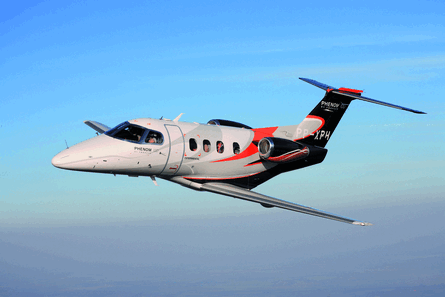Embraer's first foray into the business aviation market began in 2000 with the launch of the Legacy 600, a derivative of the Brazilian manufacturer's once popular ERJ-135 regional jet.
But the turning point for the company's business jet strategy really came in 2005. That year saw Embraer announce a vision for the business jet market that would rival in ambition its successful thrust into the regional jet market nearly a decade before.
Embraer's business jet strategy starts from a similarly blank slate as its regional business 15 years ago, and is gaining ground rapidly.
 |
|---|
© Embraer |
With only one business jet launched before 2005, Embraer's portfolio now offers six different business jet types. They range from the Phenom very light and light jets to the Legacy 450 and 500 in the mid-size category, the Legacy 600 and, finally, to a VIP version of the 90-seat 190 called the Lineage 1000.
"Today we are the number six [original equipment manufacturer], but we expect by 2015 we will be one of the top players in the market," says Claudio Galdo Camelier, Embraer's vice-president of market intelligence for executive jets.
Camelier will not say where Embraer hopes to be in seven years, but notes: "I assure you that we don't want to be number six."
A strong indicator of the company's progress could rest on Embraer's progress with the Phenom 100 and Phenom 300. The market has already pronounced its pleasure with Embraer's offerings, signing more than 800 orders sealed with non-refundable deposits, according to the company's data.
The Phenom 100 is the first aircraft to market and accounts for about two-thirds of all sales, Camelier says. About 15% of that number comes from the owner-flown market, versus charter and corporate fleets.
The first member of the Phenom family is now nearing the end of a flight-test and certification phase. But the technical risk of designing and certificating an all-new jet could even be eclipsed by the struggle to keep pace with production demand.
Two aircraft a month are being completed at the Phenom final assembly centre in Gaviao Peixoto. That is expected to rise to seven a month by January, then climb steeply through the end of 2009. Embraer is projecting to ramp up production from 12 to 15 aircraft this year to between 120 to 150 in 2009, including starting final assembly of the Phenom 300 on the same line.
The plan to escalate production tenfold within 12 months will require not only Embraer to maximise its own production efficiency, but also that of its supply chain.
"We have actions that we call production readiness activities," says Luis Carlos Affonso, executive vice-president, Embraer executive aviation. "So we are visiting [suppliers] and making reviews with them and making sure they are all ready for November."
In late August, Embraer "had a meeting with all of the suppliers talking about exactly that", he says. "One [area of focus] is maturity. The second one is readiness for production and support. All of that is important to have mature products. Suppliers must have the ability to move fast and [also] to support it because the fleet will grow fast. We are planning and working in advance to make it work."
The manufacturing system includes building up the wings and fuselage in Botucatu, Brazil, and transporting them about 150km (90 miles) to Gaviao Peixoto for final assembly. In 2010, Embraer plans to open a second final assembly line and customer demonstration centre for Phenom jets in Melbourne, Florida, expanding the company's production footprint from Brazil and China to the USA for the first time.
The certification schedule has already slipped from September to November, as Embraer works to resolve minor timing issues.
"One is the flap system on the aircraft," Camelier says. "We are working with Eaton on the software certification of the flap actuators. We have a big team of engineers working there with them in order to be sure they will be ready to certify and deliver in November."
At least one supplier has already been eliminated from the programme. Embraer has selected DeCrane Aerospace and Goodrich to replace an Italian supplier for the cabin and flightdeck seats, respectively.
"We are finalising the certification of these seats and also working very closely with these two suppliers to be sure," Camelier says.
Source: Flight International
















